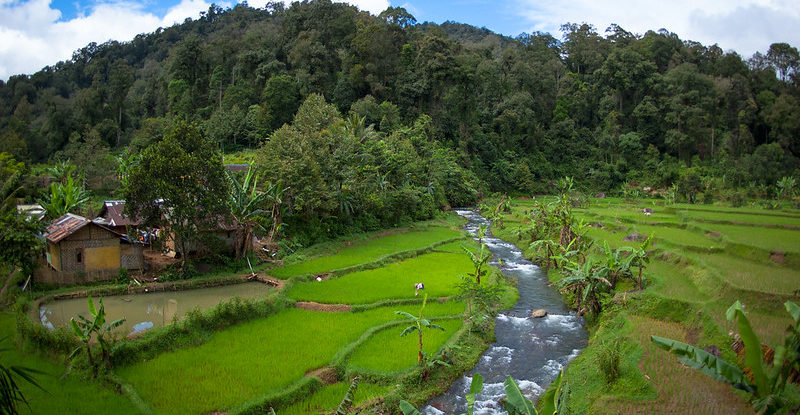
Fieldwork in Ghana, Zambia and Indonesia is demonstrating how integrated landscape approaches (ILAs) can be used to resolve land-use conflicts while empowering local producers and communities to meaningfully participate in multi-stakeholder negotiations for the sustainable use of land and natural resources.
That is one of the key tenets in a new book, Operationalizing Integrated Landscape Approaches in the Tropics, which documents early results from applying ILAs – a holistic approach to achieving resilient landscapes while protecting their ecosystems and livelihoods. The book, released during the Global Landscapes Forum (GLF) Biodiversity Digital Conference, emphasizes the need for evidence-based monitoring and reporting to encourage informed use of ILAs.
Tailored to specific local needs, widespread use of ILAs could solve a multitude of problems facing the global environment, according to the Collaborating to Operationalise Landscape Approaches for Nature, Development and Sustainability (COLANDS) initiative, which produced the book. Chapters are based on field experiences, observations and theory as well as profiles of the research sites in each of the three tropical countries where COLANDS is actively working.
“We know that landscape approaches are conceptually attractive and offer considerable potential to address socio-economic and environmental trade-offs facing people and nature in complex tropical landscapes,” said James Reed, COLANDS team leader and one of three co-editors.
During the launch, Reed highlighted some of the continuing challenges of implementing and maintaining ILAs, such as engaging traditionally opposed stakeholders and managing different expectations. He stressed the need for further evidence documenting their progress.
Integrating biodiversity and ecosystem services is also a vital element of “integrated” landscape approaches, which must go beyond integration of sectors such as agriculture and forestry alone, said Joli Rumi Borah, a post-doctoral research fellow at Canada’s University of British Columbia and COLANDS team member.
“These components influence each other in many ways, and trade-offs and synergies will occur while addressing these at a landscape level,” she told the online GLF session attended by about 600 people around the globe.
“A greater focus on ecology and its integration into landscape approaches is essential to better understand trade-offs and synergies between conservation and development, as biodiversity is key to livelihoods, food security and human wellbeing,” added Borah.
Colas Chervier of the French Agricultural Centre for International Development (CIRAD) emphasized the importance of using theories of change and combining different types of evaluation to understand enabling conditions, processes and outcomes of landscape approaches. “Only then are we able to learn lessons from implementation,” he said.
Tackling trade-offs is among the challenges in Northern Ghana, given the large number of diverse stakeholders in the landscape – from farmers, herders and forest operators, to non-governmental organizations (NGO), private companies and governments, all with different interests, objectives, perceptions and expectations, said Eric Bayala, a COLANDS Ph.D. candidate at the University of Amsterdam conducting his research in Ghana. There, consultations and negotiations are supported by a number of existing multi-stakeholder platforms in the region, such as the Community Resource Management Committees (CRMC) in the Community Resource Management Areas (CREMAs).
“In this context we are seeing that landscape approaches appear to be useful to reconcile the various objectives,” said Bayala.
Supporting local stakeholders in balancing the conservation of sensitive landscapes while achieving sustainable livelihoods from traditional activities has been an important element of the work of COLANDS in Indonesia, explained Valentinus Heri, executive director of the NGO Riak Bumi, COLANDS’ local partner in the Kapuas Hulu regency of West Kalimantan. There, despite the expansion of large-scale industrial plantations, pro-conservation livelihood strategies including the collection of non-timber forest products such as illipe nut and wild-bee honey are still an important source of income. Landscape approaches are working to bridge conservation and development objectives among communities, NGOs, governments, and the private sector.
ILAs are based on building capacity to implement and evaluate integrated approaches to landscape governance, multi-stakeholder consultations and negotiations of trade-offs between potentially competing land uses. According to COLANDS research, this should eventually contribute to global and national policy recommendations based on lessons learned. In fact, a number of United Nations conventions have begun promoting ILA strategies to address many of the interconnected social, political, economic and environmental challenges in tropical frontier landscapes.
A critical feature of operationalizing landscape approaches is mobilizing different stakeholders to deal with conflicting land uses and conservation-development trade-offs, as no sector can do that on its own, said Mirjam Ros-Tonen, an associate professor at the University of Amsterdam in the Netherlands and a co-editor the book.
“It will not always be easy to accommodate different interests and powers,” said Ros-Tonen. “But thanks to the COLANDS initiative, there is a way towards closing the gap between theory and implementation and gaining more insights into what works and what doesn’t work,” she said.
The direct and honest appraisal of landscape approaches is the foundation of the COLANDS initiative and its research, said Terry Sunderland, co-editor of the book and a professor of tropical forestry at the University of British Columbia and senior associate at CIFOR.
“Ultimately, the question is: how can we devise more integrated processes that allow us to learn from the local stakeholders – arguably, the real experts, who are already living and working in mosaic landscapes?” said Sunderland.
We want you to share Forests News content, which is licensed under Creative Commons Attribution-NonCommercial-ShareAlike 4.0 International (CC BY-NC-SA 4.0). This means you are free to redistribute our material for non-commercial purposes. All we ask is that you give Forests News appropriate credit and link to the original Forests News content, indicate if changes were made, and distribute your contributions under the same Creative Commons license. You must notify Forests News if you repost, reprint or reuse our materials by contacting forestsnews@cifor-icraf.org.